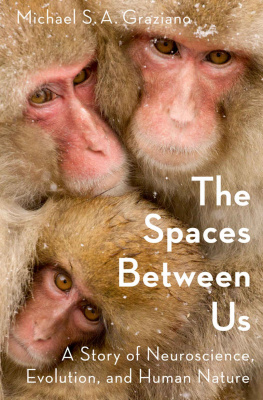Michael Graziano - The Spaces Between Us
Here you can read online Michael Graziano - The Spaces Between Us full text of the book (entire story) in english for free. Download pdf and epub, get meaning, cover and reviews about this ebook. year: 2017, publisher: Oxford University Press, genre: Romance novel. Description of the work, (preface) as well as reviews are available. Best literature library LitArk.com created for fans of good reading and offers a wide selection of genres:
Romance novel
Science fiction
Adventure
Detective
Science
History
Home and family
Prose
Art
Politics
Computer
Non-fiction
Religion
Business
Children
Humor
Choose a favorite category and find really read worthwhile books. Enjoy immersion in the world of imagination, feel the emotions of the characters or learn something new for yourself, make an fascinating discovery.
- Book:The Spaces Between Us
- Author:
- Publisher:Oxford University Press
- Genre:
- Year:2017
- Rating:4 / 5
- Favourites:Add to favourites
- Your mark:
- 80
- 1
- 2
- 3
- 4
- 5
The Spaces Between Us: summary, description and annotation
We offer to read an annotation, description, summary or preface (depends on what the author of the book "The Spaces Between Us" wrote himself). If you haven't found the necessary information about the book — write in the comments, we will try to find it.
The Spaces Between Us — read online for free the complete book (whole text) full work
Below is the text of the book, divided by pages. System saving the place of the last page read, allows you to conveniently read the book "The Spaces Between Us" online for free, without having to search again every time where you left off. Put a bookmark, and you can go to the page where you finished reading at any time.
Font size:
Interval:
Bookmark:
A Story of Neuroscience, Evolution,
and Human Nature
MICHAEL S. A. GRAZIANO


Oxford University Press is a department of the University of Oxford. It furthers the Universitys objective of excellence in research, scholarship, and education by publishing worldwide. Oxford is a registered trade mark of Oxford University Press in the UK and certain other countries.
Published in the United States of America by Oxford University Press
198 Madison Avenue, New York, NY 10016, United States of America.
Oxford University Press 2018
All rights reserved. No part of this publication may be reproduced, stored in a retrieval system, or transmitted, in any form or by any means, without the prior permission in writing of Oxford University Press, or as expressly permitted by law, by license, or under terms agreed with the appropriate reproduction rights organization. Inquiries concerning reproduction outside the scope of the above should be sent to the Rights Department, Oxford University Press, at the address above.
You must not circulate this work in any other form and you must impose this same condition on any acquirer.
Library of Congress Cataloging-in-Publication Data
Names: Graziano, Michael S. A., 1967 author.
Title: The spaces between us : a story of neuroscience, evolution, and human nature / Michael S. A. Graziano.
Description: New York, NY : Oxford University Press, [2018]
Identifiers: LCCN 2017004294 (print) | LCCN 2017024720 (ebook) | ISBN 9780190461027 (UPDF) | ISBN 9780190461034 (EPUB) | ISBN 9780190461010 (hardback)
Subjects: LCSH: Cognitive neuroscience. | Brain. | Consciousness. | Personal space. | BISAC: PSYCHOLOGY / Cognitive Psychology.
Classification: LCC QP360.5 (ebook) | LCC QP360.5 .G73 2018 (print) | DDC 612.8/233dc23 LC record available at https://lccn.loc.gov/2017004294
This book is for the Gross lab, where so many of us grew up.
Peripersonal neurons are cells in the brain that monitor the space around the body. Their activity rises like a Geiger counter to indicate the location of objects entering a margin of safety. The neurons can detect an intruding object through vision, hearing, touch, and even by the memory of where objects are positioned in the dark.
In the psychology literature of the 1960s, personal space referred to a social safety buffer around the body that varied in size depending on anxiety, status, and other factors.
In the past few years, researchers have begun to realize just how deep the connection runs between the personal space of psychology and the peripersonal neurons of the brain, and just how connected they are to our everyday behavior.
W E ALL HAVE AN INVISIBLE, PROTECTIVE BUBBLE around us. Personal space, margin of safety, bad breath zone, duck-and-flinch bufferwhatever you call it, we have it constantly switched on like a force field. It comes in layers, some layers close to the skin like a bodysuit, others farther away like a quarantine tent. Elaborate networks in the brain monitor those protective bubbles and keep them clear of danger by subtly, or sometimes drastically, adjusting our actions. You walk through a cluttered room weaving effortlessly around the furniture. A pigeon swoops past your head in the street and you duck. You stand a little farther from your boss than from your friend, and much closer to your lover. Usually hidden under the surface of consciousness, occasionally rising into awareness, personal space affects every part of human experience.
In this book I tell the story of personal space. The story extends from initial observations made almost a hundred years ago to the most recent, ongoing experiments in neuroscience. In the first part of the book I describe how scientists in the early twentieth century made a series of observations about zebras, birds, Frenchmen, Americans, and other fascinating animals. Their investigations were often colorful, sometimes a little horrifying, but led to foundational ideas about how we organize the spaces around our bodies.
Then I describe how neuroscientists (including myself) uncovered an astonishing and elegant mechanism in the brain that monitors personal space and coordinates the actions that steer us clear of danger. The neuroscience of personal space is one of the most beautiful and simple stories in brain science, and also now one of the best understood.
The remaining chapters describe the most recent insights into how our invisible second skin impacts almost every aspect of our lives. We wrap our personal space around handheld tools such as forks or golf clubs. Nobody would ever pass a driving test if we couldnt extend our margin of safety around the edges of the car. The way people stand near each other at a party is determined by the unconscious rules of personal space. A model poses in a fashion magazine with her head tilted and her long neck revealed, as if at a primal level shes saying, Im exposing my carotid artery. See how far Ive dropped my defensive shield for you? Even a smile may have originally evolved from a simple defensive cringe that says, Youre bigger than me and Im definitely not a threat! In these and many other ways, the hidden story of personal space connects specific mechanisms in the brain with the psychology of everyday events, our social behavior, and the evolution of our most human characteristics, such as facial expressions and tool use.
The final chapter of this book tells a personal story. When that invisible second skin breaks down, the results can be devastating, rippling outward into all aspects of life. I saw it first-hand in my son, who was born with subtle inconsistencies in his ability to process space and coordinate movement. What seemed like a minor setback, surely easy to overcome with physical therapy, spun out of control, and his elementary school experience came crashing down on him. With a disrupted personal space you cannot properly interface with the rest of the world. Sitting at a desk, holding a pencil, playing tag with a group of kids, judging the right interpersonal distances in the classroomall of these ordinary abilities were disrupted. His teachers were so disturbed by a feeling of strangeness about his behavior that they rejected him and actually tried to kick him out of school. We had to go to court to show that he had a disability and that it could be helped by specific interventions.
Although I had studied personal space for years, I didnt understand it until I encountered it in that frightening personal context. It isnt a scientific abstraction. Its real, and it infiltrates almost all aspects of our lives.
This book is meant for anyone interestedwhether youre a student, a parent, a scientist, or any philosopher of life. The science is explained as clearly as I know how to do so, assuming no specialized background knowledge. I wanted to write a story that anyone would be interested in reading. At the same time, I did not simplify. In any scientific story, the quirks and complications are often the most interesting parts, if they can be presented clearly. Therefore, I hope this book is just as valuable to my colleagues in neuroscience as to anyone else. My goal in writing this book was to convey the richness and relevance of an astonishing, ongoing area of scientific research that is not as well known to the public as it should be.
is waiting for you. He greets you in a friendly, reassuring manner. His assistant, operating a hand-crank movie camera, records the encounter. You have no idea why anyone would film this exam. No one has explained the visit to you. As you stand in front of the charming Dr. Strauss, a hidden, second assistant creeps up silently behind you, holds a handgun just behind your head, aims it at the ceiling, and fires a shot. Your extreme reaction is recorded on film, and Dr. Strauss has his data. Thank you for your participation. You may go now.
Font size:
Interval:
Bookmark:
Similar books «The Spaces Between Us»
Look at similar books to The Spaces Between Us. We have selected literature similar in name and meaning in the hope of providing readers with more options to find new, interesting, not yet read works.
Discussion, reviews of the book The Spaces Between Us and just readers' own opinions. Leave your comments, write what you think about the work, its meaning or the main characters. Specify what exactly you liked and what you didn't like, and why you think so.












